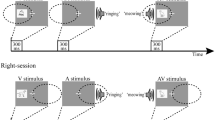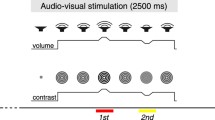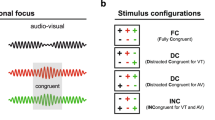Abstract
Attentional cognitive control regulates the perception to enhance human behaviour. The current study examines the atltentional mechanisms in terms of time and frequency of EEG signals. The cognitive load is higher for processing local attentional stimulus, thereby demanding higher response time (RT) with low response accuracy (RA). On the other hand, the global attentional mechanisms broadly promote the perception while demanding a low cognitive load with faster RT and high RA. Attentional mechanisms refer to perceptual systems that afford and allocate the adaptive behaviours for prioritizing the processing of relevant stimuli based on the local and global features. The early sensory component of C1, which was associated with the local attentional mechanism, showed higher amplitudes than the global attentional mechanisms in parieto-occipital regions. Further, the local attentional mechanisms were also sustained in N2 and P3 components increasing higher amplitude in the left and right hemispheric sides of temporal regions (T7 and T8). Theta band frequency had shown higher power spectrum density (PSD) values while processing local attentional mechanisms. However, the significance of other frequency bands was noticeably minute. Hence, integrating the attentional mechanisms in terms of ERP and frequency signatures, a hybrid custom weight allocation model (CWAM) was built to assess and predict the contribution of insignificant channels to significant ones. The CWAM model was formulated based on the computational linear regression derivatives. All the derivatives are computationally derived the significant score while channelizing the hierarchical performance of each channel with respect to the frequent and deviant occurrences of global–local stimulus. This model enables us to configure the neural dynamicity of cognitive allocation of resources within the different locations of the human brain while processing the attentional stimulus. CWAM is reported to be the first model to evaluate the performance of the non-significant channels for enhancing the response of significant channels. The findings of the CWAM model suggest that the brain's performance may be determined by the underlying contribution of the non-significant channels.









Similar content being viewed by others
Data availability
The data supporting this study's findings are available on request from the corresponding author [Dr. Arindam Bit]. The data privacy/consent of the research participants may be compromised; hence, it is not publicly available.
References
Andersen SK, Müller MM, Hillyard SA (2015) Attentional selection of feature conjunctions is accomplished by parallel and independent selection of single features. J Neurosci 35(27):9912–9919. https://doi.org/10.1523/JNEUROSCI.5268-14.2015
Aydın S (2021) Cross-validated adaboost classification of emotion regulation strategies identified by spectral coherence in resting-state. Neuroinformatics 1:3. https://doi.org/10.1007/s12021-021-09542-7
Aydın S, Akın B (2022) Machine learning classification of maladaptive rumination and cognitive distraction in terms of frequency specific complexity. Biomed Signal Process Control 77:103740. https://doi.org/10.1016/J.BSPC.2022.103740
Aydın S, Demirtaş S, Tunga MA, Ateş K (2018) Comparison of hemispheric asymmetry measurements for emotional recordings from controls. Neural Comput Appl 30(4):1341–1351. https://doi.org/10.1007/s00521-017-3006-8
Bhuvaneswari P, Kumar JS (2015) Influence of linear features in nonlinear electroencephalography (EEG) signals. Proc Comput Sci 47(C):229–236. https://doi.org/10.1016/j.procs.2015.03.202
Bogacz R, Wagenmakers EJ, Forstmann BU, Nieuwenhuis S (2010) The neural basis of the speed-accuracy tradeoff. Trends Neurosci 33(1):10–16. https://doi.org/10.1016/j.tins.2009.09.002
Gupta V, Chopda MD, Pachori RB (2019) Cross-subject emotion recognition using flexible analytic wavelet transform from EEG signals. IEEE Sens J 19(6):2266–2274. https://doi.org/10.1109/JSEN.2018.2883497
Hofheimer JA (2020) Neuropsychological assessment. Encycl Infant Early Child Dev. https://doi.org/10.1016/B978-0-12-809324-5.05854-5
Lin YQ, Cui SS, Du JJ, Li G, He YX, Zhang PC, Fu Y, Huang P, Gao C, Li BY, Di Chen S (2019a) N1 and P1 components associate with visuospatial-executive and language functions in normosmic Parkinson’s disease: An event-related potential study. Front Aging Neurosci 10:1–9. https://doi.org/10.3389/fnagi.2019.00018
Alhalaseh R, Alasasfeh S (2020) Machine-learning-based emotion recognition system using EEG signals. Computers 9(4):1–15. https://doi.org/10.3390/computers9040095
Barceló F, Cooper PS (2018) An information theory account of late frontoparietal ERP positivities in cognitive control. Psychophysiology. https://doi.org/10.1111/psyp.12814
Blasi G, Goldberg TE, Elvevåg B, Rasetti R, Bertolino A, Cohen J, Alce G, Zoltick B, Weinberger DR, Mattay VS (2007) Differentiating allocation of resources and conflict detection within attentional control processing. Eur J Neurosci 25(2):594–602. https://doi.org/10.1111/j.1460-9568.2007.05283.x
Brydges CR, Anderson M, Reid CL, Fox AM (2013) Maturation of cognitive control: delineating response inhibition and interference suppression. PLoS ONE 8(7):1–8. https://doi.org/10.1371/journal.pone.0069826
Brydges CR, Barceló F, Nguyen AT, Fox AM (2020) Fast fronto-parietal cortical dynamics of conflict detection and context updating in a flanker task. Cogn Neurodyn 14(6):795–814. https://doi.org/10.1007/s11571-020-09628-z
Brydges CR, Clunies-Ross K, Clohessy M, Lo ZL, Nguyen A, Rousset C, Whitelaw P, Yeap YJ, Fox AM (2012) Dissociable components of cognitive control: An event-related potential (ERP) study of response inhibition and interference suppression. PLoS ONE 7(3):3–7. https://doi.org/10.1371/journal.pone.0034482
Bunge SA, Dudukovic NM, Thomason ME, Vaidya CJ, Gabrieli JDE (2002) Immature frontal lobe contributions to cognitive control in children: Evidence from fMRI. Neuron 33(2):301–311. https://doi.org/10.1016/S0896-6273(01)00583-9
Cavanagh JF, Frank MJ (2014) Frontal theta as a mechanism for cognitive control. Trends Cogn Sci 18(8):414–421. https://doi.org/10.1016/j.tics.2014.04.012
Chamberlain R, Van der Hallen R, Huygelier H, Van de Cruys S, Wagemans J (2017) Local-global processing bias is not a unitary individual difference in visual processing. Vis Res 141:247–257. https://doi.org/10.1016/j.visres.2017.01.008
Chen T, Kendrick KM, Feng C, Sun S, Yang X, Wang X, Luo W, Yang S, Huang X, Valdés-Sosa PA, Gong Q, Fan J, Luo YJ (2016) Dissociable early attentional control mechanisms underlying cognitive and affective conflicts. Sci Rep 6:1–11. https://doi.org/10.1038/srep37633
De Boeck P, Jeon M (2019) An overview of models for response times and processes in cognitive tests. Front Psychol. https://doi.org/10.3389/fpsyg.2019.00102
De Vries IEJ, Van Driel J, Karacaoglu M, Olivers CNL (2018) Priority switches in visual working memory are supported by frontal delta and posterior alpha interactions. Cereb Cortex 28(11):4090–4104. https://doi.org/10.1093/cercor/bhy223
DeLaRosa BL, Spence JS, Motes MA, To W, Vanneste S, Kraut MA, Hart J (2020) Identification of selection and inhibition components in a Go/NoGo task from EEG spectra using a machine learning classifier. Brain Behav 10(12):1–15. https://doi.org/10.1002/brb3.1902
Friedman NP, Robbins TW (2022) The role of prefrontal cortex in cognitive control and executive function. Neuropsychopharmacology 47(1):72–89. https://doi.org/10.1038/s41386-021-01132-0
Gabrys RL, Tabri N, Anisman H, Matheson K (2018) Cognitive control and flexibility in the context of stress and depressive symptoms: the cognitive control and flexibility questionnaire. Front Psychol 9:1–19. https://doi.org/10.3389/fpsyg.2018.02219
Gan S, Yang J, Chen X, Yang Y (2015) The electrocortical modulation effects of different emotion regulation strategies. Cogn Neurodyn 9(4):399–410. https://doi.org/10.1007/s11571-015-9339-z
Gao Z, Dang W, Wang X, Hong X, Hou L, Ma K, Perc M (2021) Complex networks and deep learning for EEG signal analysis. Cogn Neurodyn 15(3):369–388. https://doi.org/10.1007/s11571-020-09626-1
Gaurav G, Anand RS, Kumar V (2021) EEG based cognitive task classification using multifractal detrended fluctuation analysis. Cogn Neurodyn 15(6):999–1013. https://doi.org/10.1007/s11571-021-09684-z
Glomb K, Cabral J, Cattani A, Mazzoni A, Raj A, Franceschiello B (2022) Computational Models in Electroencephalography. Brain Topogr 35(1):142–161. https://doi.org/10.1007/s10548-021-00828-2
Gordon N, Tsuchiya N, Koenig-Robert, R, Hohwy J (2019). Expectation and attention increase the integration of top-down and bottom-up signals in perception through different pathways. PLoS biol 17(4):e3000233
Gratton G, Cooper P, Fabiani M, Carter CS, Karayanidis F (2018) Dynamics of cognitive control: theoretical bases, paradigms, and a view for the future. Psychophysiology 55(3):1–29. https://doi.org/10.1111/psyp.13016
Hassan, T, Prasad B, Meek BP, Modirrousta M (2020). Attitudes of psychiatry residents in Canadian universities toward neuroscience and its implication in psychiatric practice. Can J Psychiatry 65(3): 174–183
Hamamouche K, Keefe M, Jordan KE, Cordes S (2018) Cognitive load affects numerical and temporal judgments in distinct ways. Front Psychol 9:1–9. https://doi.org/10.3389/fpsyg.2018.01783
Huang Y, Xu Z, Xiong S, Sun F, Qin G, Hu G, Peng B (2018). Repopulated microglia are solely derived from the proliferation of residual microglia after acute depletion. Nat neurosci 21(4): 530–540
Ji LJ, Yap S, Best MW, McGeorge K (2019) Global processing makes people happier than local processing. Front Psychol 10:1–10. https://doi.org/10.3389/fpsyg.2019.00670
Jiang J, Zhang Q, Van Gaal S (2015) EEG neural oscillatory dynamics reveal semantic and response conflict at difference levels of conflict awareness. Sci Rep 5:1–11. https://doi.org/10.1038/srep12008
Kanske P, Plitschka J, Kotz SA (2011) Attentional orienting towards emotion: P2 and N400 ERP effects. Neuropsychologia 49(11):3121–3129. https://doi.org/10.1016/j.neuropsychologia.2011.07.022
Kaya M, Mishchenko Y (2019) Distinguishing mental attention states of humans via an EEG-based passive BCI using machine learning methods. Expert Syst Appl 134:153–166. https://doi.org/10.1016/j.eswa.2019.05.057
Lin YQ, Cui SS, Du JJ, Li G, He YX, Zhang PC, Fu Y, Huang P, Gao C, Li BY, Di Chen S (2019b) N1 and P1 components associate with visuospatial-executive and language functions in normosmic Parkinson’s disease: An event-related potential study. Front Aging Neurosci 10:1–9. https://doi.org/10.3389/fnagi.2019.00018
Liu D, Wang Z, Wang L, Chen L (2021) Multimodal Fusion Emotion Recognition Method of Speech Expression Based on Deep Learning. Front Neurorobot. https://doi.org/10.3389/fnbot.2021.697634
Luck SJ, Heinze HJ, Mangun GR, Hillyard SA (1990) Visual event-related potentials index focused attention within bilateral stimulus arrays. II. Functional dissociation of P1 and N1 components. Electroencephalogr Clin Neurophysiol 75(6):528–542. https://doi.org/10.1016/0013-4694(90)90139-B
Luck SJ, Woodman GF, Vogel EK (2000) Event-related potential studies of attention. Trends Cogn Sci 4(11):432–440. https://doi.org/10.1016/S1364-6613(00)01545-X
Mahajan R, Bansal D (2017) Real Time eeg based cognitive brain computer interface for control applications via arduino interfacing. Proc Comput Sci 115:812–820. https://doi.org/10.1016/j.procs.2017.09.158
Mann T, Zilles K, Dikow H, Hellfritsch A, Cremer M, Piel M, Wree A (2018) Dopamine,noradrenaline and serotonin receptor densities in the striatum of hemiparkinsonian rats following botulinum neurotoxin-A injection. Neurosci 374:187–204.
Menon V, D’Esposito M (2022) The role of PFC networks in cognitive control and executive function. Neuropsychopharmacology 47(1):90–103. https://doi.org/10.1038/s41386-021-01152-w
Mukul MK (2011) BSS-based feature extraction from EEG signals for brain-machine interface (Doctoral dissertation, Thesis University of Electro communications-2011).
O’Reilly RC, Herd SA, Pauli WM (2010) Computational models of cognitive control. Curr Opin Neurobiol 20(2):257–261. https://doi.org/10.1016/j.conb.2010.01.008
Ordónez, FJ, De Toledo, P, Sanchis A (2013). Activity recognition using hybrid generative/discriminative models on home environments using binary sensors. Sens 13(5):5460–5477
Pedregosa F, Grisel O, Weiss R, Passos A, Brucher M, Varoquax G, Gramfort A, Michel V, Thirion B, Grisel O, Blondel M, Prettenhofer P, Weiss R, Dubourg V, Brucher M (2011) Scikit-learn: machine learning in python. J Mach Learn Res 12:2825–2830
Prabu Kumar A, Omprakash A, Kuppusamy M, KN M, BWC S, PV V, Ramaswamy P (2020) How does cognitive function measured by the reaction time and critical flicker fusion frequency correlate with the academic performance of students? BMC Med Educ 20(1):1–12. https://doi.org/10.1186/s12909-020-02416-7
Rawls E, Miskovic V, Lamm C (2020) Delta phase reset predicts conflict-related changes in P3 amplitude and behavior. Brain Res 1730:146662. https://doi.org/10.1016/j.brainres.2020.146662
Rezaeezadeh M, Shamekhi S, Shamsi M (2020) Attention Deficit Hyperactivity Disorder Diagnosis using non - linear univariate and multivariate EEG measurements: a preliminary study. Phys Eng Sci Med 43(2):577–592. https://doi.org/10.1007/s13246-020-00858-3
Schapkin SA, Raggatz J, Hillmert M, Böckelmann I (2020) EEG correlates of cognitive load in a multiple choice reaction task. Acta Neurobiol Exp 80(1):76–89. https://doi.org/10.21307/ane-2020-008
Schubring D, Schupp HT (2019) Affective picture processing: Alpha- and lower beta-band desynchronization reflects emotional arousal. Psychophysiology 56(8):1–13. https://doi.org/10.1111/psyp.13386
Slagter HA, Kok A, Mol N, Talsma D, Kenemans JL (2005) Generating spatial and nonspatial attentional control: An ERP study. Psychophysiology 42(4):428–439. https://doi.org/10.1111/j.1469-8986.2005.00304.x
Slotnick SD (2018) The experimental parameters that affect attentional modulation of the ERP C1 component. Cognit Neurosci 9(1–2):53–62. https://doi.org/10.1080/17588928.2017.1369021
Strotzer M (2009) One century of brain mapping using Brodmann areas. Clinic Neuroradiol 19(3):179–186
Tanovic E, Pruessner L, Joormann J (2018) Attention and anticipation in response to varying levels of uncertain threat: An ERP study. Cogn Affect Behav Neurosci 18(6):1207–1220. https://doi.org/10.3758/s13415-018-0632-2
Tao, S, Shen, C, Zhu L, Dai T (2020). SVD-CNN: A convolutional neural network model with orthogonal constraints based on SVD for context-aware citation recommendation. Comput Intell Neurosci. https://doi.org/10.1155/2020/5343214
Taylor MJ (2002) Non-spatial attentional effects on P1. Clin Neurophysiol 113(12):1903–1908. https://doi.org/10.1016/S1388-2457(02)00309-7
Vahid A, Mückschel M, Stober S, Stock AK, Beste C (2020) Applying deep learning to single-trial EEG data provides evidence for complementary theories on action control. Commun Biol. https://doi.org/10.1038/s42003-020-0846-z
Van Diepen RM, Foxe JJ, Mazaheri A (2019) The functional role of alpha-band activity in attentional processing: the current zeitgeist and future outlook. Curr Opin Psychol 29:229–238. https://doi.org/10.1016/j.copsyc.2019.03.015
Vogel EK, Luck SJ (2000) The visual N1 component as an index of a discrimination process. Psychophysiology 37(2):190–203. https://doi.org/10.1017/S0048577200981265
Walsh BJ, Buonocore MH, Carter CS, Mangun GR (2011) Integrating conflict detection and attentional control mechanisms. J Cogn Neurosci 23(9):2211–2221. https://doi.org/10.1162/jocn.2010.21595
Wang L, Liu X, Guise KG, Knight RT, Ghajar J, Fan J (2010) Effective connectivity of the fronto-parietal network during attentional control. J Cogn Neurosci 22(3):543–553. https://doi.org/10.1162/jocn.2009.21210
Wilsch A, Mercier MR, Obleser J, Schroeder CE, Haegens S (2020) Spatial attention and temporal expectation exert differential effects on visual and auditory discrimination. J Cogn Neurosci 32(8):1562–1576. https://doi.org/10.1162/jocn_a_01567
Zhang GL, Li H, Song Y, Yu C (2015) ERP C1 is top-down modulated by orientation perceptual learning. J vis 15(10):1–11. https://doi.org/10.1167/15.10.8
Zheng X, Chen W (2021) Biomedical signal processing and control an attention-based Bi-LSTM method for visual object classification via EEG. Biomed Signal Process Control 63:102174. https://doi.org/10.1016/j.bspc.2020.10217428
van Zutphen L, Siep N, Jacob GA, Goebel R, Arntz A (2015). Emotional sensitivity, emotion regulation and impulsivity in borderline personality disorder: a critical review of fMRI studies. Neurosci Biobehav Rev 51:64–76
Acknowledgements
The authors would like to thank the reviewers for their thoughtful comments and constructive suggestions in improving the quality of the manuscript. This research was supported by the National Institute of Technology, Raipur and Amity University Chhattisgarh.
Author information
Authors and Affiliations
Corresponding author
Ethics declarations
Conflict of interest
The authors don’t have any conflict of interest relating to the publication of this research article.
Consent to participate
Participants were voluntarily given written consent to participate in the study.
Ethical approval
Methodological techniques and procedures executed in this study concerning participants were in accordance with the ethical and moral standards of the Indian Council of Medical Research (ICMR 2017) guidelines.
Additional information
Publisher's Note
Springer Nature remains neutral with regard to jurisdictional claims in published maps and institutional affiliations.
Supplementary Information
Below is the link to the electronic supplementary material.
Rights and permissions
Springer Nature or its licensor holds exclusive rights to this article under a publishing agreement with the author(s) or other rightsholder(s); author self-archiving of the accepted manuscript version of this article is solely governed by the terms of such publishing agreement and applicable law.
About this article
Cite this article
Prasad, R., Tarai, S. & Bit, A. Investigation of frequency components embedded in EEG recordings underlying neuronal mechanism of cognitive control and attentional functions. Cogn Neurodyn 17, 1321–1344 (2023). https://doi.org/10.1007/s11571-022-09888-x
Received:
Revised:
Accepted:
Published:
Issue Date:
DOI: https://doi.org/10.1007/s11571-022-09888-x




